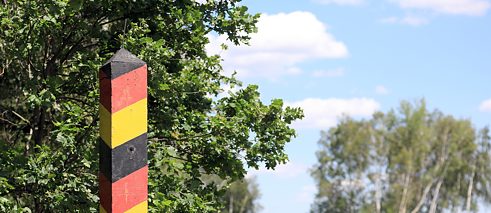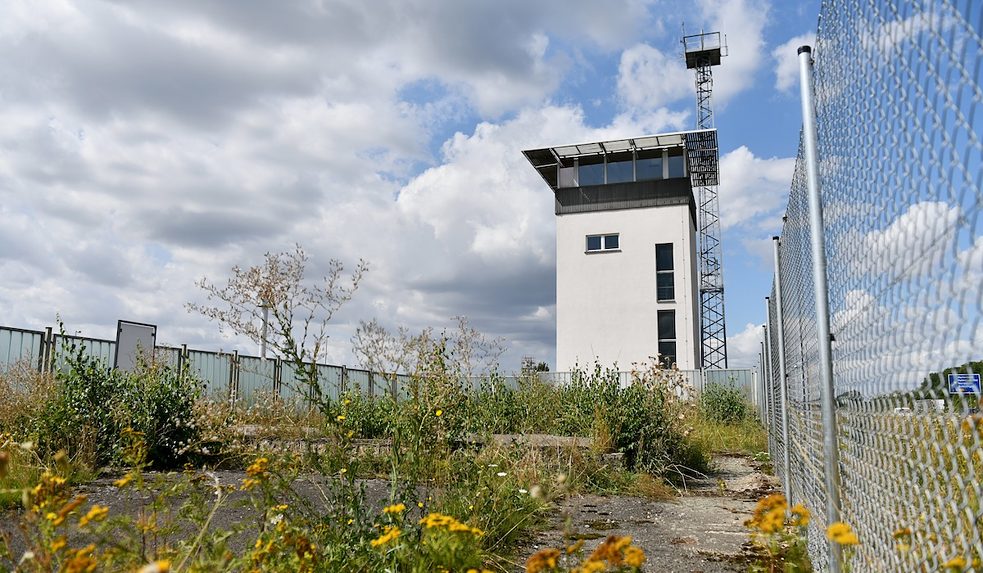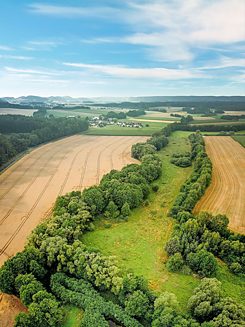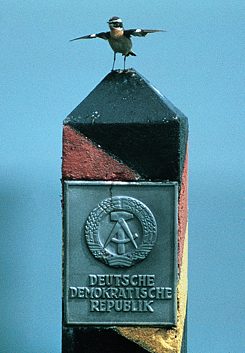The German-German border
“A place of remembrance and hope”

The border that once divided the two Germanys - the Federal Republic of Germany and the German Democratic Republic – has been transformed into the German Green Belt. The biotope provides a new home for flora and fauna while testifying to its conflict-laden history.
The small, light railway moves slowly through in Blankenberg in Thuringia, bumping along through the green landscape towards the old paper mill. The narrow-gauge railway runs directly along the former border between East and West Germany. Things were not this peaceful in a divided Germany, the locomotive driver recalls: “Back then I had to crawl around holding a long pole to search for mines,” he says. That was in the 1980s, when he completed his compulsory military service in the GDR army.
The Iron Curtain once bisected the entire country, from the Baltic Sea to Bavaria in the south. Metal fences, first outfitted with mines and later with spring guns, secured the no man’s land that marked the border. Several hundred people trying to flee the GDR to the West are estimated to have died here from when Germany was divided until reunification in 1989.
Nature has reclaimed the area today. The German Green Belt wends north to south, a full 1,393 kilometres long. Over the decades, this space that could not be entered without permission developed into a retreat for a multitude of rare and endangered animal and plant species. Large parts of the area are now protected and offer a unique blend of nature, history and culture.
 A watchtower where GDR guards once surveyed the border is now in the middle of the Green Belt in Marienborn. The border crossing point was the largest and most important checkpoint on the German-German border and was mainly used for transit traffic to West Berlin. | Photo (detail): © picture alliance/ Frank May
A watchtower where GDR guards once surveyed the border is now in the middle of the Green Belt in Marienborn. The border crossing point was the largest and most important checkpoint on the German-German border and was mainly used for transit traffic to West Berlin. | Photo (detail): © picture alliance/ Frank May
Early cooperation among conservationists
 The Green Belt in Thuringia-Bavaria near Mitwitz where the idea for the Green Belt was born. | Photo (detail): © Otmar Fugmann
Hubert Weiger, Chairman of Friends of the Earth Germany (BUND), played a leading role in this process. BUND developed the concept for the Green Belt and is still actively involved in purchasing or exchanging parcels of land in the former border region that are then converted into biotopes.
The Green Belt in Thuringia-Bavaria near Mitwitz where the idea for the Green Belt was born. | Photo (detail): © Otmar Fugmann
Hubert Weiger, Chairman of Friends of the Earth Germany (BUND), played a leading role in this process. BUND developed the concept for the Green Belt and is still actively involved in purchasing or exchanging parcels of land in the former border region that are then converted into biotopes.
The idea of preserving the former border as a nature reserve arose immediately after the fall of the Berlin Wall in 1989. Weiger, who is from West Germany, had already established contacts with East German conservationists. Four weeks after the border opened, BUND hosted a meeting in Hof, Bavaria. 400 people came. “This was the first time the words ‘Green Belt’ were spoken,” Weiger says.
Implementing the plan was not particularly easy: “Apparently establishing a border is simpler than removing one.” An alternative proposal to construct a motorway along the former border was shelved quite quickly. The Federal Agency for Nature Conservation (BfN) has supported the environmentalists’ efforts for many years. The BfN funded a study that confirmed the unique nature of the former border area as a linked chain of valuable biotopes. By 2019, the BfN had invested around 56 million euros in a large number of projects in the various regions, projects bolstered by donations and subsidies from the federal states.
Conflict-laden idyll
 One of the Green Belt’s representative species, a whinchat, perches to sing on a post to mark the former border. | Photo (detail): Thomas Stephan
The old border strip is up to 200 metres wide in places. It is home to over 5,200 animal and plant species, of which at least 1,200 are on the Red List of Threatened Species. The former Column Trail points the way along the route. There are reminders at the area’s dark history, like a few of the once 600 watchtowers that have been preserved and hint at the former brutal border regime. Tourists hike and cycle today where border guards once patrolled.
One of the Green Belt’s representative species, a whinchat, perches to sing on a post to mark the former border. | Photo (detail): Thomas Stephan
The old border strip is up to 200 metres wide in places. It is home to over 5,200 animal and plant species, of which at least 1,200 are on the Red List of Threatened Species. The former Column Trail points the way along the route. There are reminders at the area’s dark history, like a few of the once 600 watchtowers that have been preserved and hint at the former brutal border regime. Tourists hike and cycle today where border guards once patrolled.
But this apparent idyll is not quite as peaceful as it may seem. Conflicts frequently arise regarding land use when local politicians or farmers refuse to give up valuable land. Not all the areas along the former border have been earmarked for nature conservation, with around 170 kilometres not included in the Green Belt at present, partly because the land is currently farmed. “Closing the gaps is one of the great challenges for the future,” Uwe Rieken, in charge of the Green Belt projects at the BfN, says.
Sometimes though, even small things cause disputes in the Green Belt. Peter Ebertsch, mayor of the Thuringian municipality of Tettau, knows a thing or two about that. He wanted to build a cycling path on the border strip, but was blocked by conservationists, who feared it would divide the biotope with serious consequences. It took a great deal of persuasion to get them on side, though Ebertsch ultimately won them over.
Conservation across borders
Today, the German Green Belt also stands for cross-border cooperation in places where the Iron Curtain once caused separation. Bavaria, for example, works closely with neighbouring Czech Republic on nature conservation issues. “For us, the Green Belt is both a place of remembrance and a place of hope,” Bavaria’s Environment Minister Thorsten Glauber says. “It is a unique opportunity to safeguard biodiversity in Europe.” The two countries share a 346-kilometre border. Deputy Minister of the Environment for the Czech Republic Vladimir Mana explains that both sides will work under the leadership of the Šumava National Park on protecting the climate and moorland over the coming six years.
 Hubert Weiger has been a driving force from day one: on 9 December 1989, the first meeting of around 400 East and West German nature conservationists took place in Hof in Upper Franconia, where the initiative to preserve the Green Belt was launched (from left to right: Walter Hiekel, Kai Frobel, Werner Westhus, Nanne Wienands, Udo Benker-Wienands, Hubert Weiger, Rainer Haupt). | Photo: © Ernst Sammer
Hubert Weiger has been a driving force from day one: on 9 December 1989, the first meeting of around 400 East and West German nature conservationists took place in Hof in Upper Franconia, where the initiative to preserve the Green Belt was launched (from left to right: Walter Hiekel, Kai Frobel, Werner Westhus, Nanne Wienands, Udo Benker-Wienands, Hubert Weiger, Rainer Haupt). | Photo: © Ernst Sammer